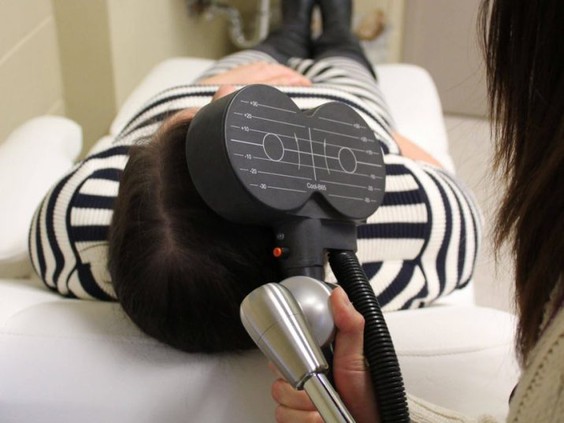You are here
Home 🌿 Medical Cannabis News 🌿 Toronto study suggests brain stimulation may reduce cannabis use in people with schizophrenia by up to 60 per cent 🌿Toronto study suggests brain stimulation may reduce cannabis use in people with schizophrenia by up to 60 per cent

Preliminary findings hint that treatment “is safe and potentially efficacious for treating cannabis use disorder in schizophrenia.”
Canadian researchers exploring what impact brain stimulation may have on people with schizophrenia — who, as a group, have a high rate of cannabis use disorder (CUD) — found the approach is associated with reduced marijuana use and might prove a treatment for CUD.
What they found was the treatment was associated with up to a 60 per cent drop in self-reported cannabis use, notes a statement from CAMH.
What is transcranial magnetic stimulation?
CAMH defines TMS as involving “a series of short magnetic pulses directed to the brain to stimulate nerve cells. The magnetic pulses stimulate area neurons and change the functioning of the brain circuits involved.”
Information from Toronto’s University Health Network notes the treatment is Health Canada-approved for depressive disorder and studies are being carried out regarding its effectiveness for conditions such as bipolar affective disorder, post-traumatic stress disorder, eating disorders and substance use disorders.
CAMH reports “studies have now found rTMS to be effective in reducing drug use and cravings for several substance use disorders in the general population.”
How does CUD affect those with schizophrenia?
Published in late February in the open access journal, Schizophrenia, the high rate of CUD in schizophrenia “negatively impacts its clinical prognosis” and they “have greater difficulty quitting cannabis,” researchers write.
With higher rates of CUD than the general population, “there is strong evidence that cannabis use worsens psychiatric symptoms and quality of life in these people,” senior author and CAMH clinician scientist Dr. Tony George says in the statement.
To shed some light on the challenge, investigators examined the effects of active vs. sham, high-frequency rTMS on cannabis use in 24 outpatients with schizophrenia and CUD as part of a double-blind, randomized trial.
CAMH explains that the brain’s dorsolateral prefrontal cortex (DLPFC), “which is associated with the brain’s reward system and executive function,” was targeted.
Nine participants received active stimulation and 10 subjects received sham rTMS five times a week for four weeks. Cannabis use was monitored weekly.
Investigators found that cannabis use, measured in grams per day, was lower in the active vs. sham group of participants.
This, they write, suggests “a clinically relevant effect of rTMS.” Additionally, members of the active group also experienced a greater reduction in craving and symptoms, improved attention and suppressed increased tobacco use associated with cannabis reductions.
Study authors write that the preliminary findings suggest rTMS to the DLPFC — a potential target for treatment development — “is safe and potentially efficacious for treating CUD in schizophrenia.”
Called the first study of its kind to investigate the effectiveness of rTMS in treating CUD in people with schizophrenia, the research was supported by the U.S. National Institute on Drug Abuse and the CAMH Foundation.
One of the reasons there is currently no effective treatment for CUD in people with schizophrenia, authors maintain, is that people with schizophrenia or other mental illnesses are usually excluded from CUD clinical trials.
“Hopefully, this work paves the way for more research into investigating the effects of rTMS as a treatment for cannabis use disorder in people with schizophrenia,” says study lead author Dr. Karolina Kozak Bidzinski.
A U.S. study published in 2018 pointed out that “rTMS can be safely and feasibly delivered to CUD participants, and treatment is well-tolerated.” That said, a single session of rTMS applied to the DLPFC “may not reduce cue-elicited craving in heavy cannabis users.”
A U.S. review published in 2021 suggested that the expanding legalization of cannabis south of the border “is associated with increases in cannabis use, and accordingly, an increase in the number and severity of individuals with” CUD.
“There is a pressing need for innovative, evidence-based treatment development for CUD,” authors noted, adding that rTMS “may be a novel, non-invasive therapeutic” tool for treating a variety of substance use disorders.
420 Intel is Your Source for Marijuana News
420 Intel Canada is your leading news source for the Canadian cannabis industry. Get the latest updates on Canadian cannabis stocks and developments on how Canada continues to be a major player in the worldwide recreational and medical cannabis industry.
420 Intel Canada is the Canadian Industry news outlet that will keep you updated on how these Canadian developments in recreational and medical marijuana will impact the country and the world. Our commitment is to bring you the most important cannabis news stories from across Canada every day of the week.
Marijuana industry news is a constant endeavor with new developments each day. For marijuana news across the True North, 420 Intel Canada promises to bring you quality, Canadian, cannabis industry news.
You can get 420 Intel news delivered directly to your inbox by signing up for our daily marijuana news, ensuring you’re always kept up to date on the ever-changing cannabis industry. To stay even better informed about marijuana legalization news follow us on Twitter, Facebook and LinkedIn.




